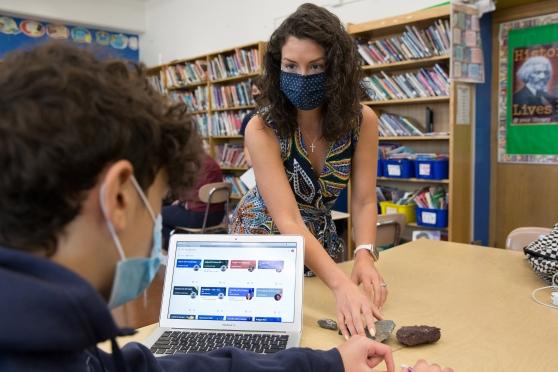
Erin Schneider of PS 232 in Queens says lessons learned while working remotely will be helpful when things return to normal.
Assessing a student’s understanding goes beyond grading their tests. Many of our true informal assessments are not necessarily rooted in coursework itself — sometimes it’s the subtle clues we accumulate that help us ascertain a student’s level of engagement and comprehension.
When we entered into the reality of two-dimensional teaching in March 2020, we lost the ability to hear a student’s sigh or see them searching through their notebooks for an answer. Teaching remotely, it was easy to question whether our lessons were truly reaching through the screens and inspiring students. What can we take away from remote learning to continue to help us assess students’ understanding?
A cornerstone to academic success has always been rooted in structure and routine. Especially for our students with IEPs and 504s, predictability is an important component to success. Establishing predictability throughout the week (including benchmarks or targets) serves to show students their progress in real time and in turn motivate them. It also helps teachers to check in with each student.
Looking at my grade book, I am able to see patterns in certain students: ones who are on task during the lesson but never complete homework, ones who partially complete homework assignments and the students who are hitting their targets every single time. A student who never completes homework might need extra one-on-one support but could feel too shy to speak up.
This time last year, I expected students to feel a sense of security behind their screens and feel more comfortable asking questions and sharing what’s on their minds. But many of us have found that remote students are in fact less willing to be “the one” who says they don’t understand.
There’s no question that one-on-one instruction is the most effective way to help a student who is struggling. But some students don’t take you up on voluntary extra support. Establishing “office hours” is one way to allow students to subtly make their way to review sessions. When they know they have time allocated to voice their concerns, students might be more inclined to reach out to us.
Teaching remotely has also had an impact on our pacing. It’s taken some time to get into a rhythm regarding how much we can accomplish in one class period. I’ve tried to take a step back and reevaluate the purpose of the content I teach. While it’s fact-heavy, much of the framework is designed to promote problem-solving, deductive reasoning and methodical approaches. Being selective, intentional and concise with assignments has enabled students to home in on key topics.
Restructuring assignments to fit this new type of learning also helps redirect our lessons from the “chalk-and-talk” model to one where learning becomes progressive. Encouraging students to complete more revisions on fewer assignments promotes an ongoing discourse and encourages self-improvement. Students may take twice as long to complete assignments, but focusing on quality over quantity has a lasting impact.
These insights from remote learning about how our students learn best will serve us well when we are all back in the classroom in September.
Erin Schneider is a STEAM teacher at PS 232 in Howard Beach, Queens.